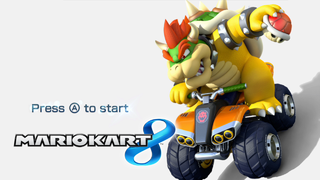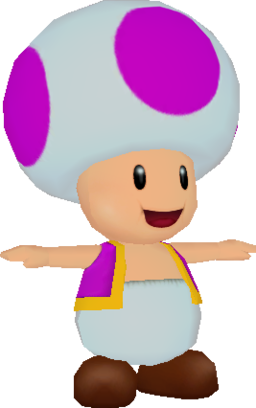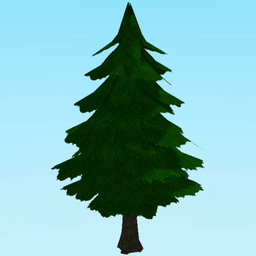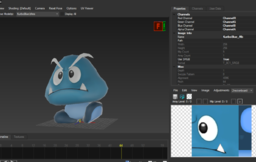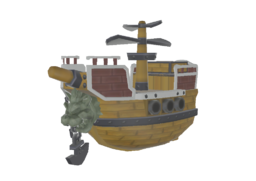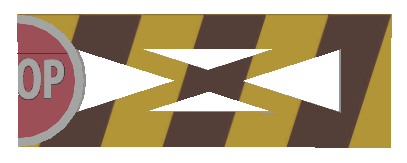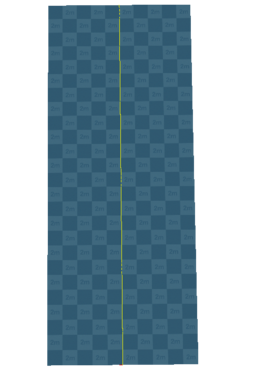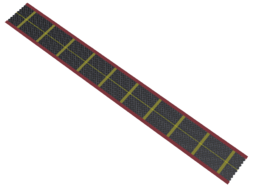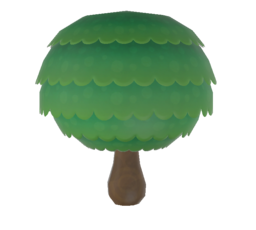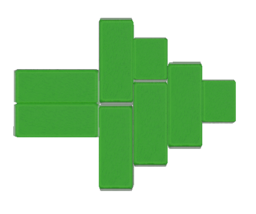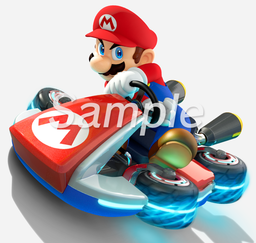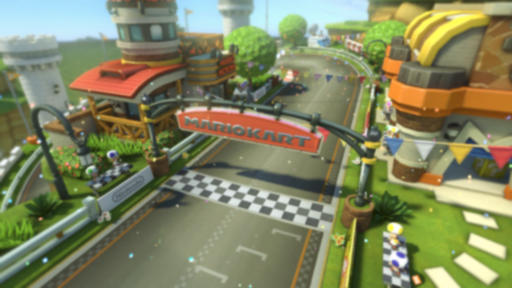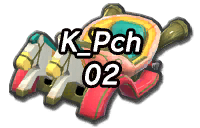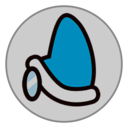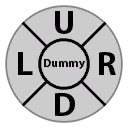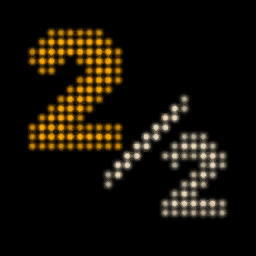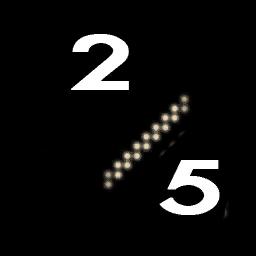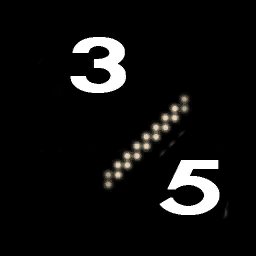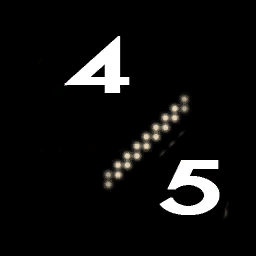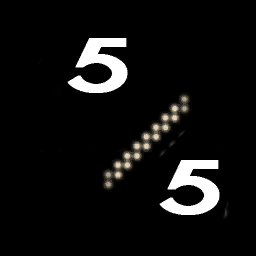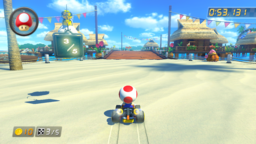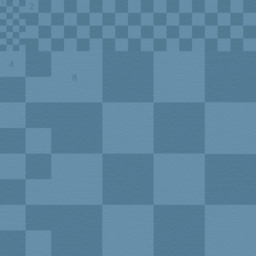If you appreciate the work done within the wiki, please consider supporting The Cutting Room Floor on Patreon. Thanks for all your support!
Mario Kart 8
| Mario Kart 8 |
|---|
|
Developers: Nintendo EAD,
Bandai Namco
|
Mario Kart 8 ajoute des mécaniques d'anti-gravité et le retour du deltaplane et des passages sous l'eau du jeu précédent. Il y a aussi les Koopalings.
Le jeu a été porté sur la Nintendo Switch sous le nom de Mario Kart 8 Deluxe. Quand le jeu de base est en grande partie le même, il a quand même reçu des amélioration de balance et des nouvelles fonctionnalités, comme être capable de tenir deux objets en même temps, un tout nouveau mode bataille avec des nouvelles arènes, six nouveaux personnages dont les Inklings de Splatoon, et trois nouveaux véhicules.
| To do: |
Contents
- 1 Sous-pages
- 2 Courses inutilisées
- 3 Modèles inutilisés
- 3.1 Toad Rose
- 3.2 Panier de fruits
- 3.3 Arbre N64
- 3.4 Arbre de la Descente Givrée sans neige
- 3.5 Plot jaune
- 3.6 Tuyaux inutilisés sans plantes Piranha
- 3.7 Drapeau du début
- 3.8 Blue Goomba
- 3.9 Airships
- 3.10 Early Balloon
- 3.11 Audience Group
- 3.12 Flat Grass Model
- 3.13 Early Flag
- 3.14 Early Trolley Gates
- 3.15 Early Tick-Tock Clock Gears
- 3.16 Early Iceberg
- 3.17 Moving Roads
- 3.18 Music Piranha Plant
- 3.19 Wii Tree
- 3.20 Early SNES Rainbow Road Arrow
- 3.21 Unused Koopa
- 3.22 Early Pitcrew Toad
- 3.23 Rotation Road
- 3.24 Skyboxes inutilisées
- 4 Unused Graphics
- 5 Unused/Test Items
- 6 Disabled Glider Closing
- 7 Shy Guy Bazaar
- 8 Regional Differences
- 9 Version Differences
- 10 Totaka's Song
- 11 Oddities
- 12 Internal Project Name
Sous-pages
| Prerelease Info (untranslated) |
| Démo de kiosque (4 Avril 2016) |
Courses inutilisées
Test
Cette course inutilisée a été trouvé à l'ID 0x01. C'est une copie du Circuit Mario de la Coupe Fleur, mais sans musique. Aussi, les panneaux oranges ne sont pas animées. Selon les interviews, le Circuit Mario est la première course crée pour le jeu, donc c'est sûrement prévu à des fins de test. Elle marche de la même façon dans le mode bataille.
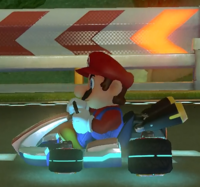
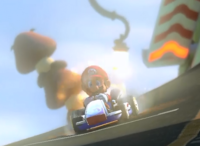
C'est probablement la course utilisée dans les vidéos du menu, car les flèches ne sont pas animées ici non plus.
ReservedXX
Des courses inutilisées qui se trouvent aux ID 0x02 à 0x0F, où XX est un nombre, commençant à 01, en sens croissant. Le jeu plante lors du chargement.
UnderConstructionXX
Il y a plus de courses inutilisées dans les IDs 0x30 à 0x4F. Elles sont similaires à ReservedXX, où XX est un nombre, à partir de 01. Ils plantent aussi lorsqu'ils sont chargés. Si les DLCs 1 et 2 sont téléchargés, les IDs 0x30 à 0x42 va charger les courses DLCs, mais les IDs 0x43 à 0x4F vont toujours planter.
Modèles inutilisés
Toad Rose
Il y a un Toad Rose inutilisé, qui aurait du être vu à la Route Arc-En-Ciel N64 avec les autres.
Panier de fruits
Un modèle interne est nommé TEST_FruitBasketB. Les textures utilisées pour le panier et les fruits sont évidemment destinées aux tests, car ce sont des simples rectangles avec une couleur et des contours.
Arbre N64
Un modèle nommé N64Tree est un arbre de mauvaise qualité basées sur ceux de l'Autodrome Mario dans Mario Kart 64. Ce modèle est notamment différent du modèle du même nom que l'on trouve dans "Mario Kart 7" et de la forme des arbres utilisés pour l'Autodrome Mario dans "Mario Kart Wii".
Arbre de la Descente Givrée sans neige
Il y a une version non enneigée des arbres contre lesquels tout le monde s'écrase dans la Descente Givrée. Il est nommé TreeTri et est correctement listé dans la table d'objets avec ObjId 5019. Comme toute la piste de la Descente Givrée se déroule dans des montagnes complètement enneigées, ils ont enlevés ces arbres. Peut-être que la piste avait des parties herbeuses au début.
A similar object in appearance was later used on Hyrule Circuit as DL_TreeTri, the only main difference having different textures than of it's unused counterpart.
Plot jaune
Quand les plots bleus/rouges sont utilisés, il y a un plot jaune utilisé dans aucune course. Il est correctement listé dans la table d'objets en PylonY (Objld 109)
Ces cônes seront finalement présents dans Mario Kart 8 Deluxe, sur SNES Arène Bataille 1.
Tuyaux inutilisés sans plantes Piranha
Il y a des tuyaux qui sont seulement vus avec des plantes Piranha. Les versions sans la plante Piranha existent et sont inutilisés. Cela pourrait indiquer qu'il y avait déjà beaucoup de tuyaux sur le circuit, ou qu'il y avait pas beaucoup de plantes dans les tuyaux.
Prévu pour la Piste aux délices, avec une texture au glaçage. Il y a deux tuyaux avec des plantes Piranha dans la course. Il est correctement listé dans la table d'objets en DokanCake (Objld 1076).
Prévu pour le Désert Toussec, avec un vert légèrement plus foncé. Il y a 2 tuyaux avec des plantes Piranha dans la course. Il est correctement listé dans la table d'objets en DokanHone (Objld 1105).
Drapeau du début
Ce drapeau du début classique est simplement appelé FlagStartMario (Objld 5024) est inutilisé. Il ressemble à une version moderne du drapeau du début au Circuit Mario GBA, mais la version finale utilise l'ancienne police d'écriture Mario Kart et des couleurs légerement différentes.
Blue Goomba
A blue Goomba named KuriboBlue, note that it seems to be an earlier model compared to the normal Goomba. It might have been intended for Piranha Plant Slide, as in MK7 the Goombas in the underground section are blue as a homage to Super Mario Brothers.
Airships
An airship model named DesertSandShip. Similar to other airship objects used in Cloudtop Cruise and Bowser's castle this object seems to have been originally intended for Bone-Dry Dunes as decoration, however lacks any animations. While ships do appear on the course they are sandships that ride on the flowing sand of the course, none appear flying in the sky. Notably the model is a direct port from Super Mario 3D Land.
A second unused airship model named Mcairship, which is the same as the others but with darker shading. From the name this airship was once used as decoration in Mario Circuit.
Early Balloon
An early balloon model with the same name as the final's, BattleBalloon. This one uses the style from the earlier games. It has an animation for all of it's colors. The early model is located in mapobj/BattleBalloon, and the final is in race_common/BattleBalloon.
Audience Group
Oddly positioned Toads and Shy Guys named CmnGroupAudience. They have bones, but no animations assigned to them.
Flat Grass Model
A flat grass model simply named Bake. Based on the texture names having "Tree64Yoshi", it was probably meant for testing bake maps using the Yoshi Valley tree.
Early Flag
An early star flag model named FlagTriangle. It has a single animation for flapping in the wind. The final model is called FlagTriangle1.
Early Trolley Gates
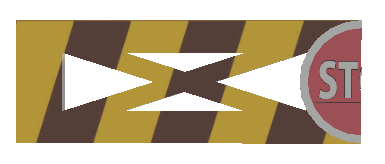
Two separate models for the Trolley toll gates at Toad Harbor named TrolleyGateLeft and TrolleyGateRight respectively. They have a single animation for opening. The final one is named TollBar.
Early Tick-Tock Clock Gears
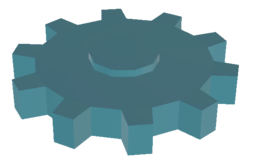
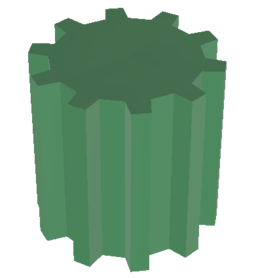
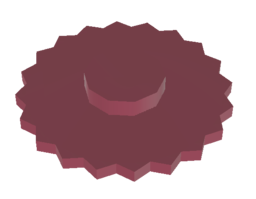
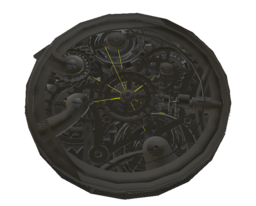
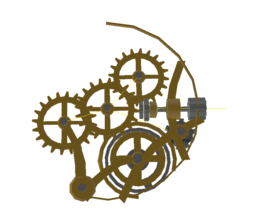
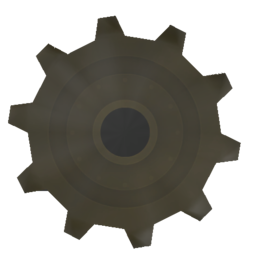
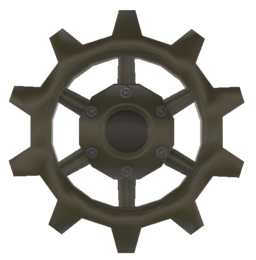
Early Tick-Tock Clock gear decorations named GearDecoA-G respectively. They all have an animation assigned to them, while GearDecoD has two animations, which seem to be a duplicate of GearDecoE's animation. The final is all in a single object in GearDeco.
Early Iceberg
An early iceberg model meant for Ice Ice Outpost named DL_IcebergA. It has a single animation for collapsing. There's another one named DL_IcebergB, but it's a duplicate of A's.
Moving Roads
A simple flat road meant for testing the wavy roads named MovingRoad. It uses a test texture with 2m written on the squares.
Another flat, longer road named MovingRoad2. This one uses a metal texture instead of the 2m texture.
A tube road most likely meant for testing a spinning road named MovingRoad3. This one uses the 2m texture.
The final moving road test named MovingRoad4. This one seems to be another spinning road test, since it does have 4 sides.
Music Piranha Plant
This Piranha Plant is meant for Music Park, however Music Park uses PackunFlower's model, but the object itself is called PackunMusic. PackunMusic's model is the piranha plant model ripped from MK7, so this one doesn't get used. It has the same animations that were used in MK7 as well.
Wii Tree
This unused tree is a higher quality version of the dancing trees from Mario Kart Wii, named WiiTree1. It has the same dancing animation from Mario Kart Wii as well. It also uses an earlier version of the bfres format.
Early SNES Rainbow Road Arrow
An early arrow meant for SNES Rainbow Road named DL_RainbowArrow. It seems like they were going to go for a more 8-bit style arrow.
Unused Koopa
An unused Koopa model named T_Nokonoko. This Koopa was meant for the Trolleys at Toad Harbor, but instead a Koopa model is included with the Trolley object. This one also has an early animation, which instead the Koopa just doesn't wave it's hands.
Early Pitcrew Toad
| Early | Final |
|---|---|
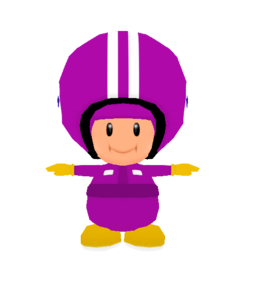 |
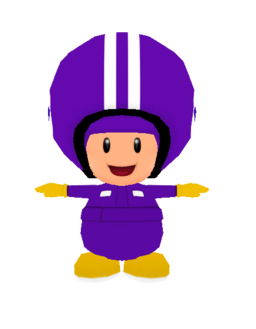 |
An early Pitcrew Toad meant for Wario Stadium named PitToadW. The color for this one represents more of Wario's overalls rather than the final's. It also doesn't open it's mouth. The final one is named PitToadWro.
Rotation Road
An unused road representing a gear model named RoadRotation1. This was most likely meant to test the rotating gears at Tick-Tock Clock.
Skyboxes inutilisées
Certaines skyboxes n'apparaissent dans aucune course.
VRfair (ObjId7006) est un ciel nuageux générique, mais avec un étrange teinte jaune vers l'horizon
VRcloudSea (ObjId 7012) aurait peut-être pu être utilisé pour le Circuit Mario, car il y a plusieurs îles à l'horizon. Cependant, la course finale utilise des îles modélisées qui ne font donc pas part de la skybox.
VRCustomizer (ObjId 7030) est un ciel bleu ciel unicolore. Le nom peut suggérer qu'il était vu dans un éditeur de course en bouche-trou jusqu'à la vraie skybox était créée.
Quand VRClock (ObjId 7034) est présente dans l'Horloge Tic-Tac et le Métro Turbo, elle n'est jamais vue en jeu, car le modèle de la course enferme les joueurs. C'est un ciel bleu foncé unicolore.
VRMenu (ObjId 7025), referenced in the internally used track Gu_Menu to draw the menu background, is not rendered when used on tracks. It only consists of the reflection map which can be indirectly seen on karts in the character and parts selection screens. On tracks, it results in no skybox being drawn at all, leaving traces of models previously rendered in front of the sky. The reflection map represents an empty hall with a lot of pillars. The game uses special coding for VRMenu, since when removing or replacing it in Gu_Menu, no menu background graphics like the main menu characters or the blue backgrounds are drawn anymore, and the whole online lobby will not be rendered at all - only the UI above remains.
Additionally, there are skyboxes listed as DL_VRAnimalSpring (ObjId 7054) and DL_VRAnimalWinter (ObjId 7055) in the object dictionary. These would've obviously been used for the spring and winter seasons of the Animal Crossing track, but spring reuses VRWaterPark and winter VRSherbet instead. They either have no data or the game doesn't render them too, as placing them in a track result in the same effects as with VRMenu.
Unused Graphics
Menu Graphics
A placeholder version of the default title screen image.
A placeholder for snapshots of 16 DLC tracks to be shown as the background in Grand Prix result screens of the corresponding cups, existing in version 1.0 of the game. Named from ym_awardbg_dlc_course_00^o.bflim to ym_awardbg_dlc_course_15^o.bflim.
A placeholder snapshot of Mario Circuit for the results screen.
An unused START! icon, in game it says GO!
There are four unused cup icons. They reuse older artwork for the central objects and lack the same extra decorations that the normal icons have. Their file names refer to them as CupIconDLC00 through CupIconDLC03, indicating that these were placeholders for the DLC cups. Of the 4 released DLC cups, only the Yoshi Egg ended up getting used (albeit with a brand new icon). However, the Spiny Blue Shell also found its way into the Switch port's Booster Course Pass DLC, also with a revamped icon. These seem to imply the initial DLC was set to be more focused on purely the Mario franchise, rather than crossing over (no pun intended) with the Legend of Zelda and Animal Crossing series.
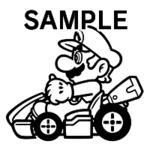
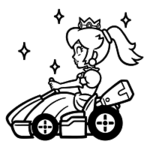
Two unused stamps. The first is a placeholder and the second is an early version of Pink Gold Peach's stamp missing the shading.
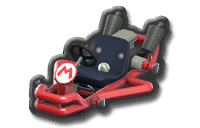
An early kart icon for the Pipe Frame. In this icon, the vehicle in question uses a design more closely resembling that seen in previous games than its final design in this one.
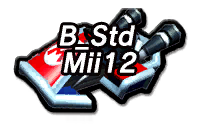
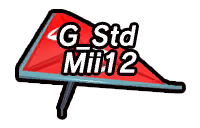
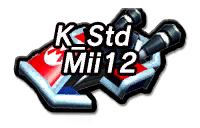
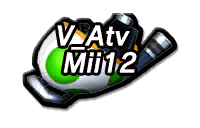

Five unused kart icons for a 13th Mii variant. The kart's variant relies on what color a player's Mii is, but there are only 12 colors to choose from. All five of the icons are placeholders using graphics from Mario Kart 7.
Icons for two planned variations of the Prancer. The Prancer is a vehicle for Peach, and since Rosalina and Daisy have alterations of Peach's vehicle parts, they were most likely planned for them. Both icons are placeholders.
Object Textures
An unused emblem for either Kamek or a generic Magikoopa. Neither appears as a playable character in the finished game or DLC packs, so he was probably scrapped during development. Kamek also appeared in pre-release screenshots of Mario Kart 64 (then called "Super Mario Kart R").
Kamek would go on to join the playable roster of Mario Kart Tour, where he does indeed use this emblem.
A generic emblem with the logo eight is included in the emblem folder, but goes unused. It is indirectly seen in pre-rendered graphics for the kart previews.
A placeholder texture for kart emblems found inside most kart model files.
Lakitu contains a texture showing a final lap or section 2 (hence the 2 is golden), but the final game always displays the 3/3 board for the last lap or section, no matter the number of total laps (except for 7 laps which it handles correctly to support Baby Park). However, during E3 2013, there were Mario Kart 8 demos in which people could try out Mario Kart 8 before its release - all races that were in the demo only had two laps, which required the use of this graphic.
In version 2.0, until version 4.0, Lakitu had placeholder lap graphics for 5 laps, using a basic font, most likely for testing. These do actually appear if a track is set to 5 laps in version 2.0 and 3.0, until GCN Baby Park was added in 4.0, which added the 7 lap graphics instead. 5 laps was also the limit in this version. Anything higher would crash the game when crossing the finish line.

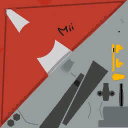
Crude textures made for the Standard Mii Glider. Both colors were dependent on which sex the Mii was; blue for female and red for male.
Track Textures
| Early | Used |
|---|---|
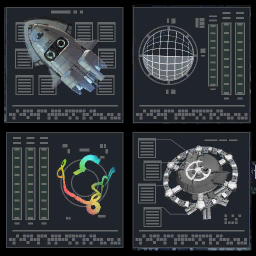 |
 |
The computer screens in Rainbow Road have 8 frames of animation, but a 9th animation frame is present. This last frame is actually an early version of the first frame. The bar charts are all empty, the infoboxes use solid lines instead of fake text, and the blue glow around the edges is missing. The Blooper shuttle is shown with different lighting and with a parallel projection, but the model itself appears to be the same. The space station is displayed at a different angle and has no textures or background. It is possible that this was a stylistic choice and does not necessarily indicate that the image was made before the texturing of the course was complete.
There are two copies of the building windows texture in Toad Harbor, one of which has big red numbers in the place of where the posters should go. The positioning of the numbers don't match the final poster placement and seem to indicate that taller or thinner posters were planned. There is also a small white and blue image next to the eighth spot. The texture itself is used on all of the windows outside of the marketplace area, and was likely left in due to the windows being identical in both versions.
The internally used track Gu_Menu actually consists of a finite small plane on which karts are placed at race start, which is also correctly textured with a test texture. This plane is not visible when running the track as the material defines to cull both back and front faces rather than only back faces. Together with no skybox being added as an object, only drawing artifacts are visible around racers.
A placeholder signboard texture found alongside a number of other signboard textures for the Excitebike track. The text on the bottom left translates to "※4:1 Non-Sign Logo Variation".
Unused/Test Items
Test Items
In the item slot table file ItemSlotTable.byaml, there are two test items called Test3 and Test4. Most likely, these items are holdovers (and serve the same lack of purpose) as the same-name items in Mario Kart 7.
Lucky Seven Leftover
In the Item Slot Table file ItemSlotTable.byaml, there is an item called Seven. It could just be a leftover for testing the Crazy 8 during development and they forgot to change the name.
Fake Item Box Leftover
In the file RaceLogData.exbin, appears the text "FakeBox" as well as all other known cut items. Since it is only referred to in that file, players can assume that they cut it really early in development.
Super Leaf Leftover
In the file RaceLogData.exbin, appears the text "Tail" as well as all other known cut items. Since it is only referred to in that file, players can assume that they cut it really early in development.
Disabled Glider Closing
Glider closing with B button from Mario Kart 7 is present in Mario Kart 8/Deluxe but it is not possible to perform because the game clears the B button input when in a glider. By removing this check, the glider can be closed by pressing B, showing that the function is left in the game and working perfectly, but not performable because of the input clear. This was discovered by Marioiscool246, who also made the cheat code to enable this feature back.
Shy Guy Bazaar
In version 2.0 of the game, present in AICourseTable_GP.byaml and AICourseTable_VS.byaml, as well as the game's code, is references for Shy Guy Bazaar (D3ds_SandTown). Shy Guy Bazaar was most likely planned to be DLC in favor of Neo Bowser City, but didn't get that far in development, since it's only a few references. All of the DLC tracks were also present in the code at this time as well, except for the seasonal Animal Crossing tracks, being only Du_Animal.
Regional Differences
Like Mario Kart 7, many tracks and parts have name differences between versions:
Track Names
The names for tracks are mostly the same between Japanese and English, standard localization aside. Retro tracks keep any name changes from the games they originated from. For example, Music Park is called Melody Motorway in the European version. For the Animal Crossing course, the Japanese version uses the game's Japanese title.
| Japanese | European | American |
|---|---|---|
| Sweets Canyon (スイーツキャニオン) | Sweet Sweet Canyon | Sweet Sweet Canyon |
| Toad Harbor (キノピオハーバー) | Toad Harbour | Toad Harbor |
| Shy Guy Mine (ヘイホーこうざん) | Shy Guy Falls | Shy Guy Falls |
| Dolphin Cape (ドルフィンみさき) | Dolphin Shoals | Dolphin Shoals |
| Electro Dream (エレクトロドリーム) | Electrodrome | Electrodrome |
| Wario Snow Mountain (ワリオスノーマウンテン) | Mount Wario | Mount Wario |
| Sky Garden (スカイガーデン) | Cloudtop Cruise | Cloudtop Cruise |
| Bone Bone Desert (ホネホネさばく) | Bone Dry Dunes | Bone-Dry Dunes |
| Koopa Castle (クッパキャッスル) | Bowser's Castle | Bowser's Castle |
| Moo Moo Country (モーモーカントリー) | Moo Moo Meadows | Moo Moo Meadows |
| Kinopio Highway (キノピオハイウェイ) | Toad's Turnpike | Toad's Turnpike |
| Crispy Desert (カラカラさばく) | Dry Dry Desert | Dry Dry Desert |
| Donut Plain 3 (ドーナツへいや3) | Donut Plains 3 | Donut Plains 3 |
| Peach Circuit (ピーチサーキット) | Royal Raceway | Royal Raceway |
| Music Park (ミュージックパーク) | Melody Motorway | Music Park |
| Tick TaClock (チックタックロック) | Tick-Tock Clock | Tick-Tock Clock |
| Piranha Slider (パックンスライダー) | Piranha Plant Pipeway | Piranha Plant Slide |
| Rumbling Volcano (グラグラかざん) | Grumble Volcano | Grumble Volcano |
| Excitebike (エキサイトバイク) | Excitebike Arena | Excitebike Arena |
| Dragon Road (ドラゴンロード) | Dragon Driftway | Dragon Driftway |
| Slippery Twister (ツルツルツイスター) | Ice Ice Outpost | Ice Ice Outpost |
| Wario Mine (ワリオこうざん) | Wario's Gold Mine | Wario's Gold Mine |
| Nature Road (ネイチャーロード) | Wild Woods | Wild Woods |
| Doubutsu no Mori (どうぶつの森) | Animal Crossing | Animal Crossing |
| Neo Koopa City (ネオクッパシティ) | Koopa City | Neo Bowser City |
| Ring Ring Metro (リンリンメトロ) | Super Bell Subway | Super Bell Subway |
An odd oversight as a result of this is that the signs in the European versions of "Music Park" and "Neo Bowser City" still use their American names.
Retro Track Systems
Keeping with their Retro Track Naming traditions started in Mario Kart DS, there is a slight difference in the initials used to indicate which system a retro track originated from between the Japanese version and other versions.
| Japanese | International |
|---|---|
| SFC | SNES |
| GC | GCN |
Bodies
| Japanese | European | American |
|---|---|---|
| Skeleton (スケルトン) | Pipe Frame | Pipe Frame |
| G Force (Gフォース) | Mach 8 | Mach 8 |
| Steel Diver (スティールダイバー) | Steel Driver | Steel Driver |
| Cat Classical (ネコクラシカル) | Cat Cruiser | Cat Cruiser |
| Turbo One (ターボ・ワン) | Circuit Special | Circuit Special |
| Tri-Mush (トライマッシュ) | Tri-Speeder | Tri-Speeder |
| Beat Demon (ビートデイモン) | Badwagon | Badwagon |
| Princess Coach (プリンセスコーチ) | Prancer | Prancer |
| Pata Tenten (パタテンテン) | Buggybud | Biddybuggy |
| Koopa Ship (クッパシップ) | Landship | Landship |
| Sneakart (スニーカート) | Bounder | Sneeker |
| Superstar (スーパースター) | Sports Coupé | Sports Coupe |
| Gold Kart (ゴールドカート) | Gold Kart | Gold Standard |
| Super Comet (スーパーコメット) | Comet | Comet |
| Mach GP (マッハGP) | Sport Bike | Sport Bike |
| Maximum (マキシマム) | The Duke | The Duke |
| Burning Bowl (バーニングボウル) | Flame Rider | Flame Rider |
| Moto-Dozer (モト・ドーザー) | Varmint | Varmint |
| Soramame (そらまめ) | Mr. Scooty | Mr. Scooty |
| Jet Rider (ジェットライダー) | Jet Bike | Jet Bike |
| Standard ATV (スタンダードATV) | Standard Quad | Standard ATV |
| Hana-chan Buggy (ハナチャンバギー) | Wild Wiggler | Wild Wiggler |
| Kuma Ride (くまライド) | Teddy Buggy | Teddy Buggy |
| Tanuki Buggy (タヌキバギー) | Tanooki Kart | Tanooki Kart |
| B Dash (Bダッシュ) | B Dasher | B Dasher |
| Master Bike (マスターバイク) | Master Cycle | Master Cycle |
| Wakuwaku Beetle (わくわくビートル) | Streetle | Streetle |
| Kisekae Scooter (きせかえスクーター) | City Tripper | City Tripper |
| Bowser Trike (バウザートライク) | Bone Rattler | Bone Rattler |
The Japanese version also calls this part a frame rather than a body.
Tires
| Japanese | European | American |
|---|---|---|
| Normal Tire (ノーマルタイヤ) | Normal | Standard |
| Wild Tire (ワイルドタイヤ) | Monster | Monster |
| Roller Tire (ローラータイヤ) | Roller | Roller |
| Ring Tire (リングタイヤ) | Slim | Slim |
| Slick Tire (スリックタイヤ) | Slick | Slick |
| Metal Tire (メタルタイヤ) | Metal | Metal |
| Button Tire (ボタンタイヤ) | Button | Button |
| Block Tire (ブロックタイヤ) | Off-Road | Off-Road |
| Sponge Tire (スポンジタイヤ) | Sponge | Sponge |
| Wood Ring (ウッドリング) | Wooden | Wood |
| Cushion Tire (クッションタイヤ) | Cushion | Cushion |
| Normal Blue (ノーマルブルー) | Normal Blue | Blue Standard |
| Wild Hot (ワイルドホット) | Funky Monster | Hot Monster |
| Sky Roller (スカイローラー) | Azure Roller | Azure Roller |
| Spicy Ring (スパイシーリング) | Crimson Slim | Crimson Slim |
| Cream Block (クリームブロック) | Retro Off-Road | Retro Off-Road |
| Gold Tire (ゴールドタイヤ) | Gold Wheels | Gold Tires |
| GLA Tire (GLAタイヤ) | GLA Wheels | GLA Tires |
| Triforce Tire (トライフォースタイヤ) | Triforce Tyres | Triforce Tires |
| Leaf Tire (リーフタイヤ) | Leaf Tyres | Leaf Tires |
The European version also calls this part a wheel rather than a tire (or tyre, as it would happen).
Gliders
| Japanese | English |
|---|---|
| Super Kite (スーパーカイト) | Super Glider |
| Billowing Balloon (もくもくバルーン) | Cloud Glider |
| Wario Kite (ワリオカイト) | Wario Wing |
| Zunguri Kite (ズングリカイト) | Waddle Wing |
| Flower Kite (フラワーカイト) | Flower Glider |
| Koopa Kite (クッパカイト) | Bowser Kite |
| Sailplane (セイルプレーン) | Plane Glider |
| Parafoil MKTV (パラフォイルMKTV) | MKTV Parafoil |
| Gold Kite (ゴールドカイト) | Gold Glider |
| Hyrule Kite (ハイラルカイト) | Hylian Kite |
| Paper Airplane (かみひこうき) | Paper Glider |
Other
There are also some regional differences in other parts of the game, like the menu text or chat macros, such as removing slang to make a translation into different languages easier.
| Text | European | American |
|---|---|---|
| 200cc mode description | Super fast - braking is crucial! | CRAZY FAST! Braking is crucial. |
| Chat macro | So unfair! | Not fair! |
| Chat macro | I'm using motion controls! | I'm using tilt controls! |
| Chat macro | I'm heading off... | I'm outta here. |
| Chat macro | Thanks very much! | Thank you! |
| Chat macro | Good night! | Goodnight! |
Version Differences
Version 2.0
The Version 2.0 update was released on August 27, 2014, and boasted the following features:
- Adds an in-game shop menu on the main start screen to purchase and download downloadable content.
- Adds a statistics menu accessible from the main start page, giving players access to the number of coins they’ve collected, win-loss record play, favorite courses, and characters, number of boosts and super boosts, etc.
- Adds the ability to display a course minimap on the TV screen by pressing the minus ("-") button on the Wii U GamePad.
- Changes the default menu option after a race to whichever option was selected after the previous race (either “Next Race” or “Watch Highlight Reel”).
- Saves each player's most recent vehicle customization to system memory, restoring it even after the Wii U is powered down and rebooted.
- Increases the maximum player race or battle rating from 9,999 to 99,999.
- Improves stability for online races and battles, as well as a number of other fixes for overall player enjoyment.
This update also changed how rating points were distributed through online matches: the required placement to gain ranking points was raised significantly for players with a large rating advantage, possibly to arrest VR and BR inflation. (This change was effectively reversed in Version 3.0.)
As of 2.0, the "random" option in online matches no longer has a chance of selecting one of the three tracks up for election (except for Battle mode, where this is still possible).
Version 3.0
The Version 3.0 update was released on November 13, 2014. This patch was required for online play.
- Adds DLC characters Tanooki Mario, Cat Peach, and Link and courses from the Egg and Triforce Cups to the online rotation, if DLC Pack 1 has been purchased. An option is provided to play online mode with downloadable courses or without, although no such feature is provided for downloadable characters.
- Preemptively implements amiibo functionality and adds the appropriate icon to the main menu (the first wave of amiibo would not be released until November 21). This feature allows players to unlock themed racing suits for Mii characters by placing a compatible figure on the Game Pad's NFC area. The Mii icon in the character select was updated to indicate this.
- Fixes balance issues and implements a number of other fixes for overall player enjoyment.
This change reverted the online rating system to follow rules similar to Version 1.0, making it easier for high-rated players to gain points.
Version 4.0
The version 4.0 update was released on April 23, 2015.
- Adds DLC characters Villager, Isabelle, and Dry Bowser, and courses from the Crossing and Bell Cups to the online rotation if DLC Pack 2 has been purchased.
- Adds 200cc as a selectable class.
- Adds new amiibo-unlocked outfits for the Bowser, Sonic, Villager, Mega Man, Rosalina, and Toad amiibo, and preemptively adds outfits for the Olimar, Wario, and Pac-Man amiibo, which would be released later.
- More Miiverse stamps are included.
Version 4.1
The version 4.1 update was released on May 1, 2015, and automatically unlocks the Mirror and 200cc classes if they weren't unlocked already, among other minor fixes.
Totaka's Song
A short signature tune of Kazumi Totaka's, this tune is hidden in almost every game in which he has composed music for. Some tracks in the game feature Yoshis that cheer for the racers, and there is a chance one of them will be singing the song (as Totaka is also the voice of Yoshi). But to make it even harder to listen to, it is low in volume and easily drowned out by the background music, the Yoshis' animations and sounds are set randomly every race, and the player cannot hear it in MKTV replays. Players must actually be racing the course.
| Track | Where it can be heard (locations are set randomly) |
|---|---|
| Sweet Sweet Canyon | One of the Yoshis at the starting area, or at the house just after the tracks merge. |
| GBA Mario Circuit | One of the Yoshis near the pitstop. |
| SNES Donut Plains 3 | One of the Yoshis standing on blocks. |
| N64 Yoshi Valley | One of the cheering Yoshis along the fence at the start of the track. |
| GCN Yoshi Circuit (DLC Pack 1) | One of the Yoshis at the start or in the tunnel. |
| GCN Baby Park (DLC Pack 2) | One of the cheering Yoshis along the edge or center of the track. |
| Super Bell Subway (DLC Pack 2) | One of the cheering Yoshis around the starting area. |
| To do: With all the locations found in the retail game and DLC Pack 1, there'll definitely be areas of interest in checking for DLC Pack 2, Animal Crossing track (K.K. Slider might be singing it), as well as the possibility that Villager and Isabelle may sing the song if sitting idle for long enough. |
Oddities
Revision Files
Beyond the base game, there are two files going by resourcerev.dat and srcrev.dat, these appear to be copied over accidentally from the stripped debug directory of the final game, they appear to contain the revision of the game data and source files.
| srcrev.dat | resourcerev.dat |
|---|---|
129722 |
129724 |
Since these are revision numbers and not unique hashes for a specific commit, it is likely that Nintendo was using Apache Subversion as their version control for Mario Kart 8.
DLC Placeholders
In DLC directories, excluding 13, 15, 17 and 19, there are some text files with no data at all, possibly to help the developers note what DLC would go here if any were added.
course_dummy.txt
course dummy file.
course_permission.txt
course permission file.
dl_permission.txt
have a permission.
dl_reservation.txt
have a reservation.
Character Audio Filename Oddities
The audio for most of the characters is mainly comprised of recordings from earlier games. Characters such as Mario, Luigi, and Wario have cleaner recordings of their Mario Kart 64 voices, but mainly for boosting and tricks. Tanooki Mario, on the other hand, has recordings coming from a slew of Mario games, such as Super Mario Advance and Sunshine to name a few. The developers even included the source game in the name of each sound file where applicable: "Kart64" for Mario Kart 64, for example.
Internal Project Name
The game's executable is referred to as Turbo.rpx. Like Super Mario 3D World, it has files throughout the game's data that also refer to the project name.
- Pages missing developer references
- Games developed by Nintendo EAD
- Games developed by Bandai Namco
- Pages missing publisher references
- Games published by Nintendo
- Pages missing date references
- Games with unused areas
- Games with unused graphics
- Games with unused models
- Games with regional differences
- Games with revisional differences
- To do
- Mario series
Cleanup > Pages missing date references
Cleanup > Pages missing developer references
Cleanup > Pages missing publisher references
Cleanup > To do
Games > Games by content > Games with regional differences
Games > Games by content > Games with revisional differences
Games > Games by content > Games with unused areas
Games > Games by content > Games with unused graphics
Games > Games by content > Games with unused models
Games > Games by developer > Games developed by Bandai Namco
Games > Games by developer > Games developed by Nintendo > Games developed by Nintendo EPD > Games developed by Nintendo EAD
Games > Games by publisher > Games published by Nintendo
Games > Games by series > Mario series
